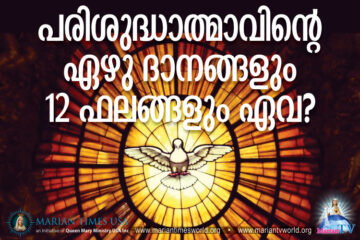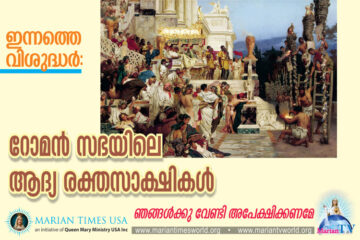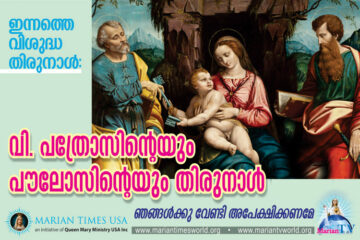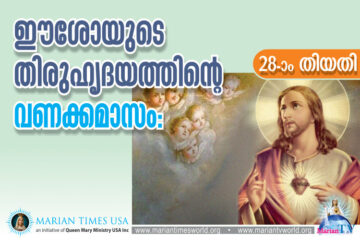JESUS PRESENTED IN THE TEMPLE (SUNDAY HOMILY)
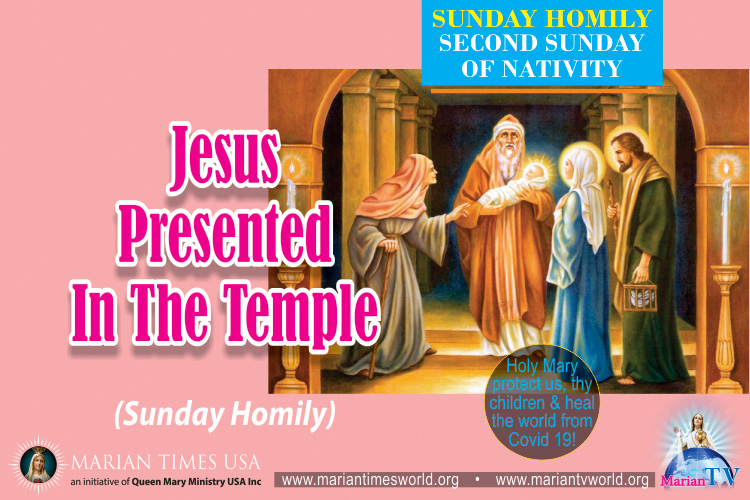
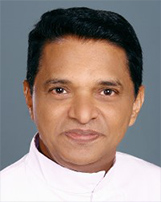
~ Fr. Abraham Mutholath ~
Chicago, USA. ~
SECOND SUNDAY OF NATIVITY
Presentation of Jesus in the temple.(Luke 2:21-38)
INTRODUCTION
Four Jewish practices were done in the life of Infant Jesus within a timeframe of 33 days. The first two were the circumcision and naming of Jesus on the 8th day and the others were the ritual purification of Mary and presentation of Jesus in the Temple of Jerusalem. Circumcision was the sign of Abrahamic covenant of the people with God. It was irrelevant in the case of Jesus because he was God incarnate. The blessed mother Mary was free from original sin and had a virgin conception through divine intervention. So, there was no need to purify her. However, the Holy Family submittedto the customary Jewish practices and set an example for us to follow the directives of Jesus and His church.
Bible Text
The Circumcision and Naming of Jesus.
(21) When eight days were completed for his circumcision, he was named Jesus, the name given him by the angel before he was conceived in the womb.
The Presentation in the Temple.
(22) When the days were completed for their purification according to the law of Moses, they took him up to Jerusalem to present him to the Lord, (23) just as it is written in the law of the Lord, “Every male that opens the womb shall be consecrated to the Lord,” (24) and to offer the sacrifice of “a pair of turtledoves or two young pigeons,” in accordance with the dictate in the law of the Lord. (25) Now there was a man in Jerusalem whose name was Simeon. This man was righteous and devout, awaiting the consolation of Israel, and the holy Spirit was upon him. (26) It had been revealed to him by the holy Spirit that he should not see death before he had seen the Messiah of the Lord. (27) He came in the Spirit into the temple; and when the parents brought in the child Jesus to perform the custom of the law in regard to him, (28) he took him into his arms and blessed God, saying: (29) “Now, Master, you may let your servant go in peace, according to your word, (30) for my eyes have seen your salvation, (31) which you prepared in sight of all the peoples, (32) a light for revelation to the Gentiles, and glory for your people Israel.” (33) The child’s father and mother were amazed at what was said about him; (34) and Simeon blessed them and said to Mary his mother, “Behold, this child is destined for the fall and rise of many in Israel, and to be a sign that will be contradicted (35) (and you yourself a sword will pierce) so that the thoughts of many hearts may be revealed.” (36) There was also a prophetess, Anna, the daughter of Phanuel, of the tribe of Asher. She was advanced in years, having lived seven years with her husband after her marriage, (37) and then as a widow until she was eighty-four. She never left the temple, but worshiped night and day with fasting and prayer. (38) And coming forward at that very time, she gave thanks to God and spoke about the child to all who were awaiting the redemption of Jerusalem.
Interpretation
The Circumcision and Naming of Jesus.
(21) When eight days were completed for his circumcision, he was named Jesus, the name given him by the angel before he was conceived in the womb.
When God made covenant with Abraham, God said, “Circumcise the flesh of your foreskin. That will be the sign of the covenant between me and you. Throughout the ages, every male among you, when he is eight days old, shall be circumcised.” (Genesis 17:11-12a). Naming the male child was done at the time of circumcision because God changed the name of Abram to Abraham when he made covenant with Abraham and established circumcision as its sign. (Genesis 17:4-5).
Eighth day has a special relevance in the Holy Bible. The creation narrative is framed within a week including the sabbath day. Eighth day, being the beginning of a new week was considered as a day of new beginning. Seven days were also considered as days of purification and the next day the day of sanctification.
Unlike at the baptism of John the Baptist (Luke 1:57-66), when Jesus was circumcised, it was not well attended by family and friends. The reason was that the Holy Family was in Bethlehem or its premises and was far away from Nazareth, their home land. So, Luke gives only a simple statement about the circumcision and naming of Jesus. Village rabbi usually performed circumcision after reciting a benediction and closing the ceremony with a prayer over a cup of wine.
This feast of circumcision and naming of Jesus falls on the New Year day in the modern times. So every New Year’s day reminds us of the baptism and naming of Jesus. We also start the New Year with resolutions for a better life especially in our covenantal relationship with God that we made at the time of our baptism.
Jesus who was God and author of the covenant had no need of circumcision. His parents knew that. Still, they obliged to the Jewish law of circumcision. Though Mary and Joseph were far from home and had inconveniences, they did the circumcision on the eighth day itself. They also obeyed to the instruction of Angel Gabriel to name the child Jesus.Jesus is Joshua in Hebrew, and Joshua means “Yahweh is salvation.” Joshua was the successor of Moses who led the Israelites to Canaan, the Promised Land. Jesus is the new Joshua who waged war against Satan, became victorious, and led his people to the new Promised Land, heaven.
The Presentation in the Temple.
(22) When the days were completed for their purification according to the law of Moses, they took him up to Jerusalem to present him to the Lord,
According to the law of Moses, there was a period of ceremonial uncleanliness for women who gave birth to children.“When a woman has a child, giving birth to a boy, she shall be unclean for seven days, with the same uncleanness as during her menstrual period.” (Lev. 12:2).Even after completing the seven days of uncleanliness, the mother had to “ spend thirty-three days more in a state of blood purity; she shall not touch anything sacred nor enter the sanctuary till the days of her purification are fulfilled.” (Lev. 2:4). If the child was female the duration of uncleanliness was 14 days and the state of blood purity was an additional 66 days. Thus the period of purification for the mother who gave birth to a male child was 40 days and a female child was 80 days.
According to biblical numerology, 40 is symbolic of a period of purification, preparation, or testing. Biologically, after giving birth a woman has a discharge known as lochia that might last for four to six weeks. The term lochia derives from the Greek word lokheíos, that means “of childbirth.” Lochia is a combination of blood, mucus and uterine tissue coming from the wound that occurred when placenta tore away from the uterine wall. It is a post-delivery healing process. During this time she was not allowed to touch anything sacred nor enter the sanctuary.
On the 40th day after childbirth, the sacrifice for cleansing was offered at the Nicanor Gate on the east of the Court of Women in the Temple. Women who lived far from the Temple were not obliged to be present in the Temple for the purification ceremony. Since Bethlehem was only six miles south of Jerusalem, Joseph and Mary went to the Temple to offer the sacrifice and to present Jesus.
(23) just as it is written in the law of the Lord, “Every male that opens the womb shall be consecrated to the Lord,”
The evangelist quotes from Exodus 13:2, “Consecrate to me every firstborn; whatever opens the womb among the Israelites, whether of human being or beast, belongs to me.” The LORD askedto tell the children of Israel the reason for the consecration of the first born: “When Pharaoh stubbornly refused to let us go, the LORD killed every firstborn in the land of Egypt, the firstborn of human being and beast alike. That is why I sacrifice to the LORD every male that opens the womb, and why I ransom every firstborn of my sons.” (Exodus 13:15). The offering of the first born male to God was a grateful remembrance of God saving the first born male of Israelites at the time of original Passover from Egypt while the first born of Egyptians were killed. (Exodus 12:12). Since Jesus was also the first born male of Mary, she and Joseph presented Jesus in the Temple.
The Israelites believed that their firstborn males and animals belonged to God. The animals were sacrificed and the humans were bought back from God by giving five shekels to a priest. That amount was worth a month’s income. That was one way of supporting the Levites or priests who were consecrated to God’s service in the place of the first born sons of Israel. (Number 3:11-13).Every firstborn of non-Levites were ransomed for five shekels. (Numbers 18:16). Usually this was done on the 30th day by presenting the child to a local priest and paying him the money. However, in Jesus’ case, the payment of money is not mentioned. Joseph and Mary took Infant Jesus to the Temple of Jerusalem and offered him to God because he was not to be ransomed but he was going to serve God and sacrifice himself like a lamb for the remission of sins of humanity. So, Joseph and Mary offered Jesus to God as an offering that would be sacrificed there after 33 years. Since the purification of Mary and presentation of Jesus in the Temple happened 40 days after Christmas, the feast falls on February 2nd according to the church calendar.
(24) and to offer the sacrifice of “a pair of turtledoves or two young pigeons,” in accordance with the dictate in the law of the Lord.
God had commanded to offer a yearling lamb as a burnt offering and a pigeon or a turtledove as a purification offering on the 40th day after giving birth to a male child. (Lev. 12:6). If the mother could not afford a lamb, she could substitute the lamb with a turtledove or a pigeon. (Lev. 12:8). Since Joseph and Mary were coming from Bethlehem and Joseph was out of work, they could not afford to buy a lamb. So they had to join other poor couples in offering only birds.
(25) Now there was a man in Jerusalem whose name was Simeon. This man was righteous and devout, awaiting the consolation of Israel, and the holy Spirit was upon him.
No one now is sure of who this Simeon was, except what we know from the description given by the evangelist. Though not all scholars agree, some identify him with Shimeon, the son of Hillel and father of Gamaliel and president of the Sanhedrin.
St. Luke gives some description about Simeon.
1) He was in Jerusalem.
Simeon being a holy and elderly man filled with Holy Spiritwas residing in Jerusalem, the Holy City of God. (Psalm 48:2, 9).
2) He was righteous.
According to the Hebrew Bible, righteousness is one of the chief attributes of God. The importance of righteousness is on good ethical conduct. “Do not act dishonestly in using measures of length or weight or capacity.” (Lev. 19:35). Noah, Abraham, Job, Joseph the foster father of Jesus and many others are characterized in the Bible as righteous people. All Christians are supposed to be imitators of God in righteousness.
3) He was devout.
The meaning of devout is God-fearing, reverential, or pious. Simeon might have been frequently visiting the Temple to keep up his devotion to God.
4) He was awaiting the consolation of Israel.
From political point of view, Israel was awaiting liberation from foreign rulers. They were continuously under pagan rulers like Assyrians, Babylonians, Persians, Greeks, and Romans. They were remembering God who delivered their ancestors from the slavery of Egypt and led them to the fertile promised land. They were expecting such a deliverer giving them freedom, peace, and prosperity.
From socio-religious point of view, the lower class people of Israel, the Samaritans and the gentiles were losing hope in salvation because the high class Jews taught that God’s favor was only for the elite group. Jesus came to offer consolation for the less fortunate in the community. Quoting from Isaiah, Jesus proclaimed: “The Spirit of the Lord is upon me, because he has anointed me to bring glad tidings to the poor. He has sent me to proclaim liberty to captives and recovery of sight to the blind, to let the oppressed go free, and to proclaim a year acceptable to the Lord.” (Luke 4:18-19). This was a spiritual liberation from the bondage of the Satan, sin, suffering and spiritual death. The liberative action of Jesus and sending his Holy Spirit brought consolation for Israel and for all the nations.
5) Holy Spirit was upon him.
This phrase is indicative of special presence of the Spirit of God on a person to accomplish a special purpose. In that sense, Simeon had a mission to give witness and prophesy on Jesus to Joseph, Mary, and to the people present in the Temple. In the New Testament, all Christians who receive baptism are endowed with the presence of the Holy Spirit to givewitness to Christ in their lives.
(26) It had been revealed to him by the holy Spirit that he should not see death before he had seen the Messiah of the Lord.
Simeon had message from the Holy Spirit that he would be fortunate to see the coming of the Messiah in his lifetime. Jesus himself later expressed that it had been a dream of many prophets and kings of the Old Testament. “Turning to the disciples in private he said, ‘Blessed are the eyes that see what you see. For I say to you, many prophets and kings desired to see what you see, but did not see it, and to hear what you hear, but did not hear it.’” (Luke 10:23-24).
Simeon was an elderly person nearing death. He was anxiously waiting for the fulfillment of this promise he had received through Holy Spirit. Bible do not say how old he was. The apocryphal book called “Gospel of Nativity” presents him as 113 years old.
(27) He came in the Spirit into the temple; and when the parents brought in the child Jesus to perform the custom of the law in regard to him,
Joseph and Mary were not expecting Simeon or Anna. Probably they might not even knew them. Joseph and Mary might have been standing in line to present Baby Jesus along with two birds for offering at the Gate of Nicanor in the Temple. Simeon was inspired by the Holy Spirit to approach the child whom he was seeing first time. Simeon was assured that the child was the Messiah.
(28) he took him into his arms and blessed God, saying:
Simeon was not blessing the child but blessing God for the grace he received to see the Infant Jesus who was going to be his Savior and consolation. He might have found himself unworthy to bless the God incarnate.
(29) “Now, Master, you may let your servant go in peace, according to your word,
The elderly Simeon found fulfillment in his life by seeing and holding the Baby Jesus Christ in his hand. He knew that he was nearing death. He was feeling satisfaction and gratefulness to God at the end of his life for the blessing he had received. He was convinced that what the Holy Spirit had communicated to him was fulfilled in seeing the Messiah. So he bid farewell to the world having received the hope of salvation for himself and the whole world.
(30) for my eyes have seen your salvation, (31) which you prepared in sight of all the peoples,(32) a light for revelation to the Gentiles, and glory for your people Israel.”
Simeon who came to meet Infant Jesus, made some prophesies about Jesus and his mother. The following were the prophesies he made about Jesus.
1) Jesus is salvation.
Meaning of the name Jesus is “Yahweh saves.” It indicated that the salvation of the world was going to be implemented through Jesus.
2) The salvation is prepared in sight of all peoples.
People of all nations could see, hear, and experience Jesus.God had promised Abraham that he would bless all nations though his chosen descendants, Israel. Many centuries before the incarnation of Christ, Isaiah had prophesied: “The LORD has bared his holy armin the sight of all the nations;All the ends of the earth can seethe salvation of our God.” (Isaiah 52:10).The angel of the Lord had said to the shepherds, “I proclaim to you good news of great joy that will be for all the people.” (Luke 2:10).
3) Jesus was light also for the Gentiles.
This means Jesus would shed light of faith to all nations who were in spiritual darkness. “He will destroythe veil that veils all peoples.” (Isaiah 25:7). “I will make you a light to the nations,that my salvation may reach to the ends of the earth.” (Isaiah 49:6).
4) Jesus brought glory to Israel.
When Jesus was born, the shepherds witnessed “a multitude of the heavenly host with the angel, praising God and saying: ‘Glory to God in the highest.’” (Luke 2:13-14). When the Messiah redeemed all nations, Israel was glorified because he was born and emerged as an Israelite.
When the Jewish leaders were very narrow minded interpreting that the Messiah was for the salvation of Israel, Simeon was predicting that the salvation was for all the nations.
(33) The child’s father and mother were amazed at what was said about him;
Though the evangelist uses “child’s father” for Joseph, he was not writing against the virgin birth of Jesus but was acknowledging the legal fatherhood of Joseph. Ordinary people understood and spoke of Joseph as the father of Jesus. It was also an expression of respect toward Joseph.
Joseph and Mary were amazed not on what they heard of Jesus because they already knew those things from their previous experiences with Angel Gabriel and what was shared by the shepherds. The reason for their wonder was that Simeon who was a stranger to them who was holy, elderly and wise was coming to them unexpectedly and prophesying exactly what they knew about Infant Jesus.
(34) and Simeon blessed them and said to Mary his mother, “Behold, this child is destined for the fall and rise of many in Israel, and to be a sign that will be contradicted.
Simeon blessed them and said to Mary his mother
Simeon did not bless the child because he knew that the child was God incarnate and did not need his blessing. Though he blessed Joseph and Mary, he addressed his prophesy on the child only to his mother Mary because Simeon knew that only Mary has blood relation to the child and only she would witness the ups and downs of Israel because of the child.
this child is destined for the fall and rise of many in Israel
According to Isaiah, “The LORD of Hosts is the One to regard as holy. Only He should be feared; only He should be dreaded, and He will be a sanctuary. But to both houses of Israel He will be a stone of stumbling and a rock of offense, a trap and a snare to the dwellers of Jerusalem.Many will stumble over these; they will fall and be broken; they will be ensnared and captured.” (Isaiah 8:13-15). Simeon was presenting to Joseph and Mary similar contradicting effects from the child. As the Lord of Hosts, Jesus will be refuge and salvation for many and will cause the destruction of others who would reject him. When Jesus taught the parable of the tenant farmers,(Luke 20:9-18) he said the owner of the vineyard would put to death the unfaithful farmers who killed his son and would hand over the vineyard to others. Then he continued quoting Psalm 118:22, “The stone which the builders rejectedhas become the cornerstone” and continued saying, “Everyone who falls on that stone will be dashed to pieces; and it will crush anyone on whom it falls.” (Luke 20:18). This destruction happened in 70 AD at the fall of Jerusalem and will happen again at the second coming of Christ when “he will say to those on his left, ‘Depart from me, you accursed, into the eternal fire prepared for the devil and his angels.’” (Matthew 25:41).How people respond to Jesus’ message during his public ministry and in the future would determine their eternal destiny. Thus Simeon’s prophesy was fulfilled in Jesus’s ministry and will be fulfilled again at his second coming.
a sign that will be contradicted
Jesus was also a sign of contradiction. The disciples of Jesus and many others received healing, peace, and salvation from him. Many loved him, gave him hospitality and supported him during his public ministry. Others opposed, humiliated, tortured, and crucified Jesus. Even after his victorious resurrection, the Jews and Romans continued to put his name down and persecute his followers for centuries.
(35) (and you yourself a sword will pierce) so that the thoughts of many hearts may be revealed.”
you yourself a sword will pierce
Mary was also destined to suffer along with her son. She witnessed the sufferings and crucifixion of her son Jesus. She witnessed the physical piercing of her son’s heart while she was at the foot of the cross. She was aware of the emotional piercing of Jesus’s heart during his public ministry, especially during his trial. Those were equivalent to emotional piercing of the heart of Mother Mary. Thus what God had said to serpent was to be fulfilled: “I will put enmity between you and the woman,and between your offspring and hers;They will strike at your head,while you strike at their heel.” Mary was also called to cooperate with her son to strike the head of the “serpent” who in turn hurt both Jesus and his mother. Simeon was reminding Mary of this call she had.
the thoughts of many hearts may be revealed.
There is a shade of evil implied in the “thoughts” when used in the Greek. The words of Jesus were sharper than a two edged sword. “Indeed, the word of God is living and effective, sharper than any two-edged sword, penetrating even between soul and spirit, joints and marrow, and able to discern reflections and thoughts of the heart.No creature is concealed from him, but everything is naked and exposed to the eyes of him to whom we must render an account.” (Hebrews 4:12-13). Those who justified themselves as righteous were rejected and the innocent and childlike were received into the Kingdom of God that Jesus reestablished.
(36) There was also a prophetess, Anna, the daughter of Phanuel, of the tribe of Asher. She was advanced in years, having lived seven years with her husband after her marriage,
a prophetess, Anna
Luke introduced Anna as a prophetess when there were lack of prophets for around 500 years after Prophet Malachi who lived around 450 BC. During this intertestamental period without any prophet, the Jews were divided as different groups and interpreted the Holy Scripture according to their own views. That was why Jesus had to reinstate the laws to their original intentions and there were disagreements between Jesus and the Jewish groups.
Though Luke presented Anna as a prophetess, she was not described as foretelling any future events. As a prophetess, she was a preacher of the Word of God especially to women who came to the Temple. Her name in Hebrew is “Hannah” which means grace. There was another prophetess in the Old Testament with the same name and similar religious practices. That was Hannah, the mother of Samuel.
There were mainly five prophetesses before Christ. Miriam, the sister of Moses was a first one (Exodus 15:20) who led the women of Israel in praising God for drowning Pharaoh and his army. Another prophetess was Deborah (Judges 4:4) who was also a judge of Israel before the rule of kings. Huldah was another prophetess (2 Kings 22:14). The other prophetesses were Noadiah (Nehemiah 6:14) and Isaiah’s wife (Isaiah 8:3). Then came Anna who came at the presentation of Jesus in the Temple. The prophetess were very few in number and served only short-term compared to male prophets of the Old Testament.
tribe of Asher
Asher was Jacob’s eighth son from Zilpah, Leah’s maid and Jacob’s concubine (Genesis 30:12–13). This tribe was one among the 10 Northern tribes that fell into idolatrous worship (2 Kings 17:16) and as a consequence was attacked and dispersed by the Assyrians in 722 BC. It is believed that a very few faithful from the ten tribes migrated to the south so that they could continue worship the true God in the Temple. However, they had to sacrifice many of their family members, friends and even land and inheritance for doing so. Anna’s family was one among such exemplary people who wanted to continue their faithfulness to the true God.
(37) and then as a widow until she was eighty-four. She never left the temple, but worshiped night and day with fasting and prayer.
Anna was married for seven years only. Then she became a widow. Instead of considering a second marriage, she dedicated her life for God in the Temple. She remained in the Temple worshipping God day and night with fasting and prayer. She was sheltered in the Temple premises as was the case of Prophetess Huldah (2 Chronicles 34:22) and spent her time in the Women’s Court. As a prophetess, she might have been guiding women who came for worship and might have volunteered to clean the Temple. Such service at the Temple was considered as a noble task for God. So, Anna might have been a familiar character for the worshippers, especially women. She also might have been a leader of a community of widows who were settled there for worship and service in the Temple.
(38) And coming forward at that very time, she gave thanks to God and spoke about the child to all who were awaiting the redemption of Jerusalem.
Anna, who was always in the Temple, came forward to meet the Holy Family because she also might have noticed the difference in the child Jesus. She also might have heard the prophesy made by Simeon. So, she thanked God for the gift of seeing the Savior born as a child. As a prophetess, she voluntarily took up the mission to preach about the Holy Child. Her target group was the people who were awaiting the redemption of Jerusalem from the foreign rulers. Anna was already a familiar and credible preacher known to the community. Anna is considered as the first woman to proclaim the good news to the public and the second evangelist after the shepherds who worshipped Infant Jesus at the manger in Bethlehem. (Luke 2:17-18).
Simeon and Anna
Why did Luke present the witness of Simeon and Anna? According to Deuteronomy 19:15, “A matter must be established by the testimony of two or three witnesses.” Simeon who was guided by the Holy Spirit and Anna, a prophetess gave witness that the Infant Jesus was the Messiah that the generations had been waiting to arrive. Both of them were holy people advanced in years. Simeon had been awaiting to see Jesus as God had revealed to him and he came at the exact time to the Temple under the guidance of the Holy Spirit. Anna was already in the Temple and came forward realizing that the Messiah was there. Simeon wanted to die in peace believing that his mission was over. However, Anna wanted to live to preach the good news to the people who were awaiting the consolation of Jerusalem.
Luke, the evangelist, was not a disciple of Jesus during his public ministry. Then how did he come to know the infancy narrative of Jesus? Luke had interviews with Mary, the mother of Jesus. Mary had kept everything that happened in the childhood of Jesus in her heart. (Luke 2:19, 51).
Message
- Since Infant Jesus was God incarnate, Joseph and Mary could take exception from circumcising the child.There was no relevance for his circumcision as a sign of his covenant with God because he was God. However, his parents respected the traditional rituals without questioning. Joseph named Jesus at the time of circumcision as the angel of the Lord had instructed him in a dream and to Mary by Angel Gabriel at the time of annunciation.Joseph and Mary are models for us in being obedient to Christ and his church.
- Joseph and Mary did not postpone the circumcision of Jesus for the convenience to be at their home town or to involve the participation of their family and friends. Instead, they followed the commandment of God given through Moses that the circumcision had to be done on the eighth day. The parents should not postpone the baptism of their children to combine it with other celebrations or for the participation of family and relatives living far away from them. “Parents are obliged to take care that infants are baptized in the first few weeks; as soon as possible after the birth or even before it, they are to go to the pastor to request the sacrament for their child and to be prepared properly for it.”(Can. 867 §1).
- God had assigned the name of Jesus through an angel to Mary and Joseph. God had given names for some chosen people and God had changed the names of some others. Christians are supposed to select the name of a saint or a name that has some Christian sense for their children. “Parents, sponsors, and the pastor are to take care that a name foreign to Christian sensibility is not given.”(Can. 855).
- Mary who was “full of Grace” and born free from original sin was pure. She had no relations with a man and gave birth in a virginal way. There was no need for her purification on the 40th day by going to the Temple and offering sacrifices. However, she humbled herself and went to the temple with a poor family’s offerings. Let us also be obedient to the laws and traditions of the church.
- Presenting the child in the Temple and redeeming the child by offering sacrifice was also not necessary in the case of Infant Jesus. However, as the evangelist states, “they had fulfilled all the prescriptions of the law of the Lord.” (Luke 2:39). When they obeyed the rituals, they experienced the blessing and prophesy of two prophets: Simeon and Anna.
- While offering Jesus, the Holy Family offered themselves at the service of the Lord. We are all called to offer ourselves at the service of the Lord.
- Like Joseph, Simeon was a righteous and devout person. Holy Spirit was guiding him. We have received the Holy Spirit at the time of our baptism. Let us also try to be righteous and committed to God.
- Anna was sharing the good news of the arrival of the Messiah after she saw Infant Jesus. We are also called to be the communicators of the Good News of Jesus Christ.
മരിയന് ടൈംസിലെ ഇന്നത്തെ പ്രധാനപ്പെട്ട അപ്ഡേറ്റുകള് താഴെ ലഭിക്കുന്നതാണ്.





